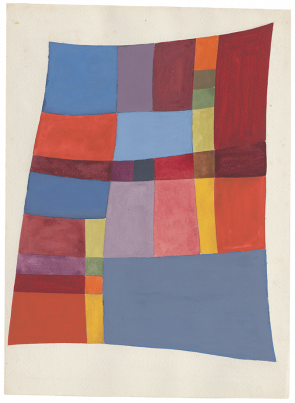Throughout the years of Dada Zurich, Sophie Taeuber, as a Swiss native an exceptional figure in the international Dada circle, walked the line between arts and crafts and artistic avant-garde. For Taeuber, applied art was what set the pace for her abstract formal inventions in free art. In the broad range of Dadaist events and publications, however, she appeared, somewhat reductively tagged, as an “artisan,” as well as an important dancer on the Dada stage. Her day job as a teacher of textile Design at the Zurich School of Arts and Crafts, which she held from 1916 to 1929, meant both a vocation and a burden to her. Her teaching duties and commissioned textile work took up much of her time and energy, and in a letter to Hans Arp she asked herself, “if there isn’t anything better to do to bide one’s time until death than toiling to make some money … and also doing beadwork, which is beautiful and all, but unreasonably laborious, because it is just fancy and doesn’t invent anything new, which is what makes the great difference between us.” At the same time, Taeuber created an avant-gardist oeuvre, which, however, she only saw as studies for her applied art. A certain reservation which she had against the “cheese brains in Zurich,” as she still noted in the 1920s, may also have contributed to the temporary isolation of these works. She first exhibited “handicrafted” puppets and Dada heads in the exhibition of the artists’ association “Das Neue Leben” (The New Life) in 1919. Pictures of them were printed in Der Zeltweg; they are the only ones published in a Dada journal.
For Taeuber, seeing all those “lines, surfaces, shapes, colours” in the works of Arp as well as of Otto and Adya van Rees in their joint exhibition at the Galerie Tanner (1915) meant both a confirmation and an impulse to pursue on her path. The exhibition marked the beginning of her private relationship and close collaboration with Arp—a collaboration so symbiotic at times that it is impossible to tell apart personal styles. From 1915, Taeuber’s free-art oeuvre included the Compositions verticales-horizontales, which made her a pioneer of Constructivist art. These were followed, under the auspices of Dada Zurich, by Rythmes libres and Taches quadrangulaires. In Rythmes libres, the strict vertical-horizontal grid seems to be set in motion by a soft wind. It is a textile sensation: the gouache transforms into a gauzy piece of cloth in a slight breeze, an exquisite case for a feathery pillow. It was only after she had quit teaching that these works found their way to the public from 1929.
Taeuber herself never added to the host of personal Dada memoirs and general Dada histories. Only few materials from her time as a teacher lay out the grammar of her applied art. Manifestos like the one by the “Radikale Künstler / artistes radicaux” (radical artists) were not her thing either: “I am fu u u u u u u u rious. What kind of rubbish is that, ‘radical artists.’ If I were an artist and would see my name being ridiculed all the time by yelling, squealing, howling, smearing and printing, I’d stuff a fistful of glue down the throat of the one responsible and bite his fingers so that he can do it no more.” Taeuber’s artistic manifesto was her uncompromising and charming self-portrait with a Dada head. It was supposed to be used by Tristan Tzara for his portrait gallery in the never-published magnum opus Dadaglobe. Even before that, Tzara had assigned her a permanent place on the pantheon list of Dada “Présidents et Présidentes.”
Provenance: Donation from Hans Arp from the artist’s estate, 1958.
First exhibitions: Winterthur, Kunstmuseum, Strasbourg, Musée d’Art Moderne, Sophie Taeuber, 1977. Zurich, Kunsthaus, Dada in Zürich, 1980. Zürich, Kunsthaus, Meisterwerke der Graphischen Sammlung, 1984.
→ Sophie Taeuber and Hans Arp with puppets for König Hirsch [King Stag], DADA VI:1
→ Hans Arp, Prä-Dada-Zeichnung [pre-Dada drawing], Z.Inv. 1990/58
→ Hans Richter, Kaiser Wilhelm als Befehlshaber des Todes [Emperor Wilhelm as the Commander of Death], Z.Inv. 1977/44

